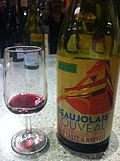Gamay
Gamay is a grape variety used to produce red wine, most notably grown in Beaujolais and in the Loire Valley around Tours. Its full name is Gamay Noir à Jus Blanc. It is a very old cultivar, mentioned as long ago as the 15th century. It has been often cultivated because it makes for abundant production; however, it can produce wines of distinction when planted on acidic soils, which help to soften the grape's naturally high acidity.
History[edit]
The Gamay grape is believed to have appeared first in the village of Gamay, Saint-Aubin, Côte-d'Or, south of Beaune, in the 1360s. The grape brought relief to the village growers following the decline of the Black Death. In contrast to the Pinot noir variety, Gamay ripened two weeks earlier and was less difficult to cultivate. It also produced a strong, fruitier wine in a much larger abundance.
In July 1395, the Duke of Burgundy Philip the Bold outlawed the cultivation of Gamay as being "a very bad and disloyal plant", due in part to the variety occupying land that could be used for the more "elegant" Pinot Noir. Sixty years later, Philip the Good, a successor of Philip the Bold, issued another edict against Gamay in which he stated the reasoning for the ban is that "The Dukes of Burgundy are known as the lords of the best wines in Christendom. We will maintain our reputation".
Viticulture[edit]
Gamay is a purple-colored grape variety and it tends to produce light bodied wines with high acidity. It is grown widely in the Beaujolais region of France and in recent years has started to make inroads into wine regions all over the world, including the Loire Valley, Switzerland, and the Niagara Peninsula in Canada.
Wine regions[edit]
In France, Gamay is particularly identified with the Beaujolais region, being used in all of the region's wines, from the light and festive Beaujolais Nouveau to the more serious and meaty Beaujolais Cru wines. It is also grown in the Loire Valley around Tours, where it is often blended with Cabernet Franc to give a wine similar to a light Bordeaux.
Outside of France, Gamay is grown in Switzerland, where it is used in wines from Geneva, Neuchâtel, and the Ticino region. It is also grown in small amounts in the Niagara Peninsula in Canada, and has been introduced into Oregon's Willamette Valley wine region, Australia, New Zealand and various parts of the United States.
Food pairing[edit]
Gamay is often used in the production of light bodied red wines, which pair well with a wide variety of foods due to their high acidity. They are particularly good with charcuterie, goat cheese, and a variety of poultry dishes.
Gamay[edit]
-
Gamay
-
Beaujolais Nouveau Wine
-
La Rochepot, Hautes Côtes du Beaune
-
Blanc de Noirs Crémant
Ad. Transform your life with W8MD's Budget GLP-1 injections from $75


W8MD offers a medical weight loss program to lose weight in Philadelphia. Our physician-supervised medical weight loss provides:
- Weight loss injections in NYC (generic and brand names):
- Zepbound / Mounjaro, Wegovy / Ozempic, Saxenda
- Most insurances accepted or discounted self-pay rates. We will obtain insurance prior authorizations if needed.
- Generic GLP1 weight loss injections from $75 for the starting dose.
- Also offer prescription weight loss medications including Phentermine, Qsymia, Diethylpropion, Contrave etc.
NYC weight loss doctor appointmentsNYC weight loss doctor appointments
Start your NYC weight loss journey today at our NYC medical weight loss and Philadelphia medical weight loss clinics.
- Call 718-946-5500 to lose weight in NYC or for medical weight loss in Philadelphia 215-676-2334.
- Tags:NYC medical weight loss, Philadelphia lose weight Zepbound NYC, Budget GLP1 weight loss injections, Wegovy Philadelphia, Wegovy NYC, Philadelphia medical weight loss, Brookly weight loss and Wegovy NYC
|
WikiMD's Wellness Encyclopedia |
| Let Food Be Thy Medicine Medicine Thy Food - Hippocrates |
Medical Disclaimer: WikiMD is not a substitute for professional medical advice. The information on WikiMD is provided as an information resource only, may be incorrect, outdated or misleading, and is not to be used or relied on for any diagnostic or treatment purposes. Please consult your health care provider before making any healthcare decisions or for guidance about a specific medical condition. WikiMD expressly disclaims responsibility, and shall have no liability, for any damages, loss, injury, or liability whatsoever suffered as a result of your reliance on the information contained in this site. By visiting this site you agree to the foregoing terms and conditions, which may from time to time be changed or supplemented by WikiMD. If you do not agree to the foregoing terms and conditions, you should not enter or use this site. See full disclaimer.
Credits:Most images are courtesy of Wikimedia commons, and templates, categories Wikipedia, licensed under CC BY SA or similar.
Translate this page: - East Asian
中文,
日本,
한국어,
South Asian
हिन्दी,
தமிழ்,
తెలుగు,
Urdu,
ಕನ್ನಡ,
Southeast Asian
Indonesian,
Vietnamese,
Thai,
မြန်မာဘာသာ,
বাংলা
European
español,
Deutsch,
français,
Greek,
português do Brasil,
polski,
română,
русский,
Nederlands,
norsk,
svenska,
suomi,
Italian
Middle Eastern & African
عربى,
Turkish,
Persian,
Hebrew,
Afrikaans,
isiZulu,
Kiswahili,
Other
Bulgarian,
Hungarian,
Czech,
Swedish,
മലയാളം,
मराठी,
ਪੰਜਾਬੀ,
ગુજરાતી,
Portuguese,
Ukrainian




